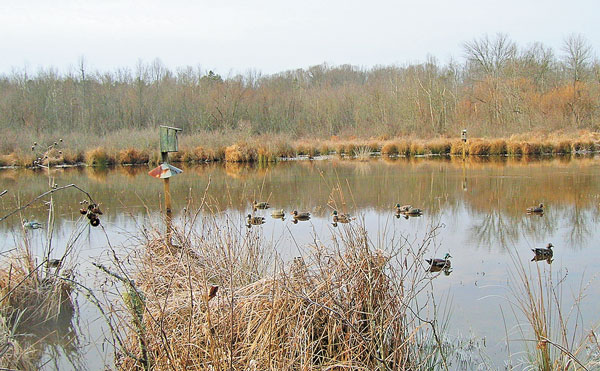
Kayaks get waterfowl hunters into productive spots others can’t reach.
Andy Stevenson borrowed a kayak back in the mid-1980s to hunt waterfowl on a unique Carolina Bay on his family’s farm near Allendale and Fairfax.
He dragged the 2-man Perception kayak through brush and navigated the shallow waters of the area, known locally as “Three Hole Bay.” The ease of paddling and silent approach made it a good sneak boat to get close to ducks before they took flight.
After a week, Stevenson, the incoming chairman of South Carolina Ducks Unlimited, bought his own kayak.
Kayaks are unique watercraft that a few knowledgeable duck hunters use to access difficult, “skinny” water. Flooded timber and debris are common and hamper access to conventional boats. Easily loaded into the back of a pick-up or on an SUV roof rack, transportation is no problem. Upon reaching the access point, they can be dragged or carried significant distances to reach secluded waters.
Throw in the ease of paddling, and you have an ideal, stealthy vessel for duck hunting.
“Although it requires a little back and arm strength, it does well in old ponds that have a lot of fallen trees and vegetation,” said Stevenson, who credits kayaks with allowing him to reach places that would have otherwise been inaccessible and improving his success rate. “It slides over logs and grass with little effort and will go where no jon boat would think of going.”
Hunting with a friend is easy from a 2-man kayak. If you plan on shooting from the craft, one man should be the designated paddler and the other the shooter. Rotation can occur after a few shots or by other mutual agreement.
Stevenson said he has kayak-hunted rice fields on the Combahee River with a friend.
“We loaded guns, waders, two bags of decoys and a small cooler, then paddled a couple of miles for a full day of hunting,” he said. “It was crowded with the gear, but the kayak performed well with a full load. We were able to slip into the marsh grass and shoot a few teal. The boat fit nicely on the roof of an old Suburban, and we just pulled off Highway 17 and slipped the kayak into a canal right beside the road.”
Stevenson’s most memorable hunt was in the late1990s in the Carolina Bay after a particularly wet summer and fall. The bay’s oaks were flooded and held hundreds of wood ducks.
“We slipped silently into the bay and quickly collected our limit of wood ducks, but the fun part was slipping around the bay and watching the birds fly in and land next to us,” he said. “It was one day to remember.”
Leif Busby, president of the Flyway Foundation — a South Carolina organization that promotes in-state waterfowl projects — is another convert to duck hunting from kayaks, for reasons similar to Stevenson’s. He loves the ease of transportation and concealment; kayaks are easily covered with camouflage netting and can even be sunk to make them less visible after reaching the hunting blind or destination. He credits kayaks with “providing access to hunts that were not otherwise accessible.”
Busby also recommends floating rivers or small streams until ducks are flushed. Stop, conceal the kayak, place a few decoys and wait for the birds to return. This has been successful for him on many occasions.
Busby said shooting from a kayak is okay if you don’t lean too far and use caution, but he remembers one time when a friend dropped his gun in the river and had to dive for it.
A good idea for kayak-hunting is to use a dry bag for firearms that is waterproof and floats. LL Bean offers such a product called the “Gun Boat.” It has a roll-down seal and a strap for carrying or securing to the kayak.
Busby has an 11-year-old Labrador that is his hunting companion, but on some of the float trips, chooses to leave “Joss” at home. An excited dog and a kayak can be a combination for disaster.
One of Busby’ best hunts was with a buddy from Columbia on an upstate river. Ponds were frozen, and most of the waterfowl were on the free-flowing rivers. They floated to a sandbar with some downed timber, where they used camouflage burlap and limbs to build a temporary blind. In a short while, they bagged two geese, three wood ducks and four mallards. The highlight was a “scotch” double: two birds with one shot.
D. J. Riley, a wildlife enforcement officer with the S.C. Department of Natural Resources out of Clemson, has used kayaks to transport he and his son, Tanner, to otherwise inaccessible spots to hunt waterfowl.
Tanner hunts several swamps where he has permission, and he uses a kayak as his means of transportation. He carries only four to six decoys and uses camouflage netting to conceal the kayak at the water’s edge where grass and shrubs allow him to blend into his surroundings.
“The biggest advantage to using a kayak to waterfowl hunt is how easy it is to get around on shallow water and being able to be quiet,” said Tanner, who stressed wearing a PFD (personal floatation device). “Kayaks can be unstable at times, and when you load a gun, decoys and shells while wearing waders, a spill in cold water can be deadly.”
In the pre-dawn stillness, nothing beats gliding silently through the water on the way to a favorite hunting spot. The only sound is the muted dipping of the paddle into the water and a slight hissing sound as the kayak’s hull knifes through the murky water.
A familiar, but always startling sound, is that of a beaver swimming alongside and slapping his flat tail on the water to warn his kin of an intruder. Disturbing a great blue heron from his resting place results in an unearthly croaking call. These kinds of occurrences are a special part of using kayaks for hunting.

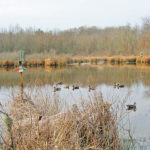
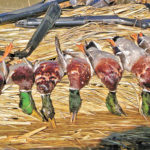
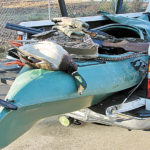
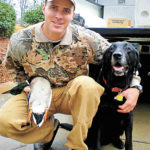
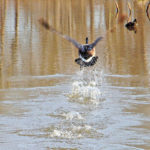


Be the first to comment